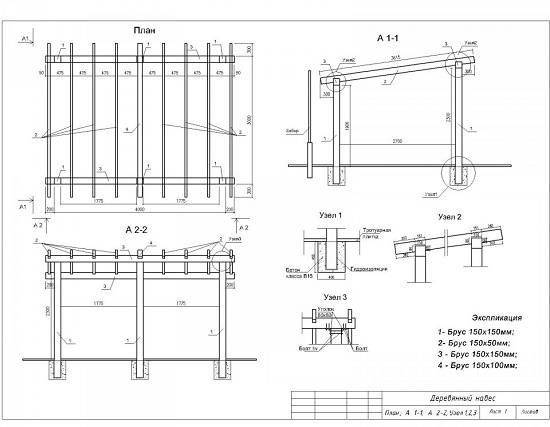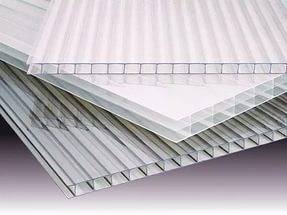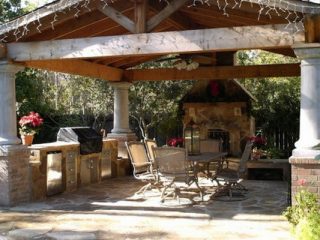Content
A gazebo or terrace attached to a house is not only a place to relax, but also serves as a decoration for the yard. In order for a building to have a presentable appearance, it is necessary to choose a reliable and beautiful roofing covering for its roof. The modern construction market offers many new materials. Let's now try to figure out how to cover the roof of a gazebo or terrace, and also consider the nuances of choosing a roofing material.
Choosing the roof shape and roofing covering
Most often, the design of gazebos does not provide for a base. Foundations must be built for terraces attached to the house. The lack of a base does not allow covering the roof with a heavy roofing covering. The roof should be light and at the same time durable.
For cooking in the fresh air, sometimes the building is equipped with barbecues, ovens, and smokehouses. In this case, the roof of the gazebo is made of non-combustible materials, and the structure itself is erected on a foundation. Here, asbestos-cement slate, ceramic tiles or any metal material are used as roofing.
The shape of the gazebo roof is selected based on the climatic conditions of the region. Flat roofs are not suitable for areas with high average annual rainfall. A large accumulation of snow will cause the roofing to bend. Steep roof slopes are not recommended for gazebos built in windy areas. Large windage will lead to rapid destruction of the roof.
To know how to make a roof on a gazebo with your own hands, you first need to decide on its shape. Each type of roof has its own rafter structure, as shown in the photo drawings of different roofs:
- The simplest shed roof is usually made in the shape of a rectangle or square. Occasionally it is diamond-shaped, which depends on the very shape of the gazebo. The structure consists of layered rafters, the support for which is the opposite walls. Most often, the veranda roof attached to the house is made pitched.
- The round shape determines only the outline of the side borders of the roof itself. The upward structure can be made in the form of a cone, dome, etc. The roof consists only of slanted rafters laid diagonally. In this case, a circular sheathing is made.
- It is easier to build a gable roof on a rectangular gazebo. The design involves the manufacture of rafters of layered or hanging type.This parameter is determined based on the type of roofing, as well as the material chosen for interior decoration.
- An oval gazebo and a semi-oval extension to the house look harmonious under a multi-pitched roof. The structure similarly consists of slanted and hanging rafters extending from the ridge.
- A gazebo with a hipped roof will decorate your yard well. This design has a ridge, from which two triangular and two trapezoidal slopes extend. Hip roofs are installed on oval and rectangular arbors. The structure consists of four slanted rafters at the corners, and a set of hanging and layered elements located between the ridge and the walls of the building.
- The hip roof is installed on square gazebos. The structure consists of four slanted rafters laid at the corners, and converging at the top at one point. There is no ridge in the hip roof.
Of all the roofs considered, the classic option is hipped and dome-shaped structures. The roof can withstand strong gusts of wind and does not retain precipitation.
Review of roofing material for gazebo roof
The roof for the gazebo is made with your own hands after all the exact calculations have been made. Roofing materials have special requirements. In addition to reliability and long service life, the roof must be attractive and also be combined with the style of the structure itself. It’s good if the roof fits harmoniously into the landscape design of the yard. If the gazebo is located close to a residential building, it is desirable that the design of both buildings overlap. Perhaps the material for the roof of the gazebo should be the same as that used to cover the residential building.
Bituminous shingles
The choice of soft tiles is optimal for complex roofs. Bitumen shingles are flexible, which allows them to be attached to any shaped areas. In terms of design, bitumen shingles outperform many of their analogues. Shingles are cut by giving its petals the shape of various geometric shapes. As a result, you get a nice pattern on the roof, reminiscent of a wave, scales, etc.
Soft tiles are quite easy to install and, if installed correctly, can last on a gazebo for up to 30 years, although for all bituminous materials the service life is approximately limited to 10 years. The roofing material is environmentally friendly, does not reflect the sounds of hitting raindrops or hail, shingles are available in different colors.
The disadvantage of asphalt shingles is the fear of strong gusts of wind until all the shingles are glued together into one monolithic covering. It is necessary to make a continuous sheathing for laying the tiles.
The video shows the installation of flexible tiles on a gazebo:
Fire resistant roofing covering
When the question arises of how to cover the roof of a gazebo, inside of which a stove or barbecue is installed, you should immediately choose non-combustible materials. Traditional asbestos-cement slate comes first here. The material is inexpensive, quick to install and quite durable. Cement-sand tiles are very heavy for a gazebo. It is better to replace it with a ceramic analogue. These tiles are attractive and have a long service life.
Corrugated sheet
Today, corrugated sheeting is the No. 1 roofing and finishing material for summer residents.Light metal sheets with a beautiful polymer coating are easy to process, easy to install, and have a long service life. You just need to take into account that different brands of corrugated sheets differ in wave height. For roofing work, sheets with appropriate markings are produced. For the gazebo, you can use any corrugated sheet with a minimum wave height of 21 mm.
Corrugated sheeting is not flammable, so it is suitable for a gazebo with a stove or barbecue. The disadvantage is the high noise level from the impact of hail or raindrops.
Metal tiles
In terms of its characteristics, metal tiles are not far removed from corrugated sheets. In principle, these are the same material only with a different profile shape. The metal tiles on the gazebo look more presentable. Thanks to a large selection of colors and profile shapes, it is possible to build luxurious roofs. The disadvantage of the material is the high cost and large amount of waste when installed on a small roof.
Transparent materials
Popular transparent roofing materials include polycarbonate. The cellular structure gives the sheet a certain flexibility, which allows it to follow the curves of the roof. Polycarbonate is produced in various colors. The transparent roof looks beautiful on a separate gazebo, as well as an open veranda attached to the house. Polycarbonate does not corrode and is quite resistant to the effects of the natural environment, but it cannot be used on gazebos with barbecues. It is not advisable to cover a building located in a region with difficult weather conditions with sheets.
Fiberglass slate
The roof covering is shaped like traditional slate. Lightweight material is made from fiberglass or modified cellulose.Attractive sheets of different colors do not corrode, are easy to process and fasten. The disadvantage is the structure of the material, which allows fungus to grow in damp conditions.
Bituminous roofing felt
The cheapest roofing material supplied in rolls. It cannot be considered as a covering for a gazebo due to its unaesthetic appearance and short service life. You can cover a gazebo located in deep thickets with roofing felt so that the appearance does not spoil the design of your yard.
Ondulin
This bitumen material is similar in structure to roofing felt and flexible tiles. The sheets were given a wavy slate shape and different colors. Lightweight, inexpensive and durable, the cover is perfect for many gazebos. Ondulin has good sound insulation, is resistant to the influence of the natural environment, and is easy to install.
What are the roofs of attached verandas covered with?
They are trying to improve the verandas or open terraces attached to the house in every possible way. The main element of the structure is the roof. To cover it, the roofing material that is laid on the house is usually selected. If you want something unusual, the roof of the extension is made transparent. Here the same polycarbonate is used. Moreover, terraces can be partially or completely glazed with these transparent sheets.
Here, in principle, are all the nuances of choosing roofing material for a gazebo and an open veranda. Don't chase cheap coverage. A gazebo is also a serious building and requires high-quality coverage.

























